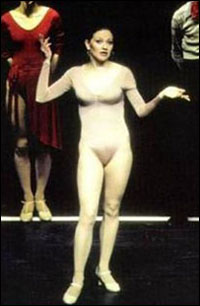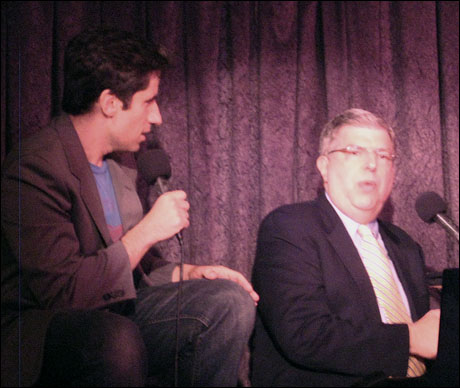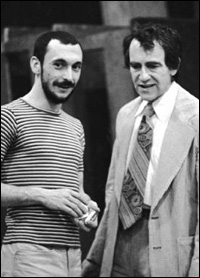
*
This past week began with the sad news about Marvin Hamlisch's death. He was an idol of mine because his music — both Broadway and pop — was such an important part of my childhood. Not only did I love his chord changes and melodies, but I especially loved his music because when it was at the height of popularity, I was a young pianist and his songs always seemed to feature the piano. A Chorus Line began with that famous piano line "da da, da dum dum dum — Again!" And the piano was prevalent throughout so many other songs in that show: the beginning of "Nothing," the famous "One" vamp and all throughout "At the Ballet," which was played on that incredibly cool 1970s electric keyboard, the Fender Rhodes. Then, pop-wise, there was that great piano intro to "The Spy Who Loved Me" and the beautiful vamp that starts "The Way We Were." When fellow SiriusXM host Christine Pedi interviewed Marvin, he said that vamp represented church bells chiming on the campus where the characters played by Robert Redford and Barbra Streisand went to college.
Speaking of SiriusXM, my regular Saturday show that I do with Christine ("The Dueling Divas") was expanded by adding some of Marvin's co-workers to share their memories: Don Pippin, (the original Chorus Line conductor and vocal arranger), Priscilla Lopez (the original Morales) and Donna McKechnie (the original Cassie). Before we played the song "Nothing" on the radio, Priscilla and Don talked about when the song was written. Priscilla remembered when Marvin and lyricist Ed Kleban first played it for her. She said she wept because they had taken one of the worst things that happened to her and turned it into one of the best things: a fantastic solo in an upcoming Broadway show! However, one day after rehearsal, the whole cast was sitting onstage getting notes and between mundane ones like, "Everyone make sure your kicks are the same height," and "Try to sing out throughout group numbers," Michael Bennett also said, "'Nothing' is cut."
 |
||
| Priscilla Lopez at the Chorus Line cast album recording session |
||
| © Sony Music Entertainment |
As much as we were all lauding that show, we also talked about how disappointing the film was. Before A Chorus Line transferred to Broadway (it started at the Public Theater), the character of Cassie would turn up after the whole opening number. She entered in a fur coat, asking if anyone had change for a cab. Donna told us her line was "Does anyone have change for a ten?," but Priscilla reminded her it was a five. Remember, this was 1975! That entrance wound up turning the audience against Cassie because it made her look like a diva and separated her from the other dancers. It was opposite the whole point of the show, which is that dancers are all the same. They all need to dance because they love it. So, Cassie was added to the opening number. Well, cut to: Years later Donna went out to lunch with Cy Feuer who was producing the Chorus Line film and when she read the script, she was horrified to see they were using the old Cassie entrance! She and Priscilla told us it was as if the scriptwriters took all the moments that hadn't worked (and were cut) and put them in the film. They laughed and said it was like they took the original A Chorus Line script before any changes were made and used it as the film script. Donna and Priscilla remembered that at one point Michael Bennett was going to direct the film. He wanted to keep the show's feeling of urgency and desperation for a job, so the film was going to be about a bunch of actors trying out for the Chorus Line film! It was going to take place on a soundstage and there'd be all different people trying out for each part. Sadly, it never happened. When the real film went into production, all the originals were given a chance to audition, but Priscilla felt it was only so Sir Richard Attenborough could say, "Well, I saw them all and they weren't right for the film." As a matter of fact, when Donna tried out, he asked her to do it again and condescendingly told her, "You know, this is film. You don't need to speak so loudly." Donna said, "But isn't Cassie onstage? Talking to a director all the way in the back of the audience?" Touche!
 |
||
| Kelly Bishop in A Chorus Line. |
***
 |
||
| Barbra Streisand |
Marvin works with Barbra Streisand a lot and, turns out, they're both very similar. They both want things to be perfect and once they're done, they're done. He said that he would be the worst pit piano player because he'd have a breakdown having to play the same thing every night. I actually enjoy doing the same things over and over again (see my stand-up act for the last ten years. Perhaps it's time to retire those Janet Reno jokes?). Anyhoo, he wrote the theme to "The Way We Were" and was watching a run of the film with a test audience and was mortified to see that there was no crying from the audience in the last scene. He, being Jewish, blamed himself. He knew if the music was right, the tears would flow. Marvin had underscored the moment when Barbra brushes away the hair on the forehead of Robert Redford with the secondary music theme of the movie, not the title song. Perhaps, he thought to himself, he was wrong? He discussed it with his orchestrator. Marvin said he didn't want the audience to hear the same theme 30 times in the same movie because it could seem tacky. The orchestrator explained that it may play 30 times, but the audience would hear it around three times. Only the composer is that honed into the music in the background throughout the whole film to really notice. Marvin decided to re-record that moment and bring in the main theme from "The Way We Were." However, the movie studio said NO WAY. They weren't going to pay for more musicians to come in and do any more playing. So…Marvin paid for it himself! That's a lot of cash-ola…it was a 55-piece orchestra! He re-recorded it, got it put in the movie and went back to another screening. He watched Barbra touch Redford's forehead…he heard the music play….and one woman sniffled. Then another. Then a bunch. Finally, Marvin heard the crying he was looking for! P.S., if he wanted so badly to hear crying in the mid-'70s, he needed only to visit my house every afternoon when I returned home from school.
That same year Marvin became an international celebrity because of the Oscars. He won Best Musical Adaptation for "The Sting," Best Score for "The Way We Were" and Best Song for "The Way We Were." That's right, he won THREE Oscars in one night! Speaking of "The Sting," for those of us who grew up as pianists, that was Marvin actually playing "The Entertainer" that we all listened to on that recording and tried to emulate. I asked him if he cheated and recorded each hand separately to make it easier...and he said he DID! Aha! But not on "The Entertainer." Only on one of the rags because, he said, it was a really hard stride left hand and busy right hand and there were other musicians playing with him. Marvin knew that if he made even one mistake, everyone would have to start the whole piece over from the top and he wanted to save them all the annoyance of having to do that.
 |
| Seth with Marvin Hamlisch |
 |
||
| Michael Bennett and Joe Papp |
||
| © Sony Music Entertainment |
***
OK, I wrote more about Marvin in an appreciation that will run in the September issue of Playbill magazine. Check it out when you see a Broadway show.
I'll conclude by saying that I knew I was such a fan of his, but I didn't realize in how many different ways he influenced me. As most of you know, I've been desperately trying to finish my sequel to my first young adult novel, "My Awesome/Awful Popularity Plan." I wrote around half of it and even though I knew what was happening plot-wise, it took me that long to finally start to understand the themes. So, I went back to the beginning and started re-writing it now that I understood more about the book. I realize now that I felt so comfortable doing that because I remembered what Marvin had told me about writing a show and then going back and writing the opening. I internally knew that going back to the beginning was the right thing to do. So, thank you, Marvin, for everything you brought to the world. And, thank for helping me finish my sequel. Last Wednesday night at 10 PM, I sent it into Random House!
For those of you as obsessed as I with Marvin's music, here are some videos: This is "At The Ballet" from the special performance when A Chorus Line became the longest running musical; here's a Playbill Obsessed video I did when I was playing Vernon in They're Playing Our Song with Sutton Foster; and here's Barbra singing one of his most gorgeous songs!
(Seth Rudetsky is the afternoon Broadway host on SiriusXM. He has played piano for over 15 Broadway shows, was Grammy-nominated for his concert CD of Hair and Emmy-nominated for being a comedy writer on "The Rosie O'Donnell Show." He has written two novels, "Broadway Nights" and "My Awesome/Awful Popularity Plan," which are also available at Audible.com. He recently launched SethTV.com, where you can contact him and view all of his videos and his sassy new reality show.)
[flipbook]





























































